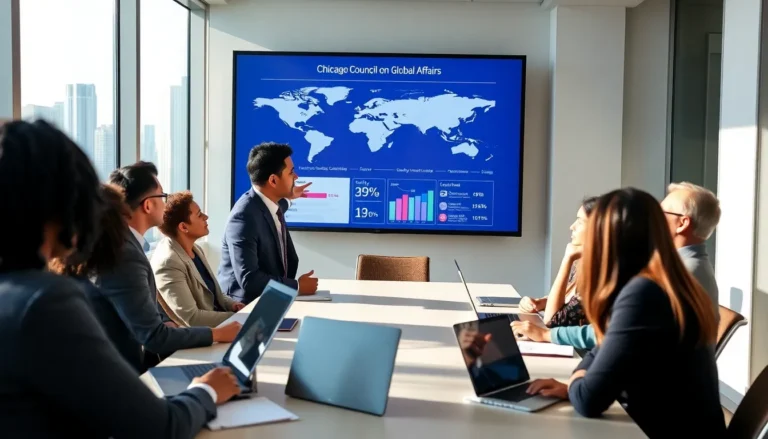Table of Contents
ToggleIn an increasingly interconnected world, understanding international risk assessment is crucial for businesses and governments alike. This process involves identifying potential threats and vulnerabilities across borders, enabling organizations to make informed decisions in the face of uncertainty. As global dynamics shift, the importance of effective risk assessment grows, influencing strategies in finance, trade, and security.
International risk assessment not only helps in navigating geopolitical challenges but also fosters resilience against economic fluctuations and environmental disasters. By evaluating risks on a global scale, organizations can better protect their assets and ensure sustainable growth. In this article, we’ll explore the key components of international risk assessment and its significance in today’s complex landscape.
Overview of International Risk Assessment
International risk assessment involves systematically identifying and evaluating risks that transcend national boundaries. It plays a crucial role in helping organizations understand potential threats. These threats can arise from political instability, economic fluctuations, and environmental issues, among other factors.
Organizations conduct this assessment to inform decision-making processes. By analyzing risks, businesses can develop robust strategies to mitigate potential impacts. Effective assessments often incorporate data analysis, expert evaluations, and scenario planning. This multidimensional approach enhances an organization’s ability to adapt to emerging challenges.
Key components of international risk assessment include:
- Threat Identification: Recognizing specific geopolitical disputes, regulatory changes, and supply chain disruptions that pose risks.
- Vulnerability Assessment: Evaluating internal weaknesses that could exacerbate risks, such as insufficient security measures or lack of contingency planning.
- Impact Analysis: Assessing the potential consequences of identified risks on operations, finances, and reputation.
- Mitigation Strategies: Developing actionable plans to reduce or eliminate identified risks, ensuring business continuity.
- Monitoring and Review: Establishing ongoing evaluation processes to adapt to evolving risks and respond to new information.
International risk assessment not only supports proactive risk management but also enhances overall resilience. As organizations face complex global dynamics, they must remain vigilant and adaptable through continuous assessment and strategic planning.
Key Components of Risk Assessment

Effective international risk assessment includes structured processes to identify and analyze threats across borders. The key components enhance organizations’ abilities to navigate complexities in a global landscape.
Risk Identification
Risk identification focuses on systematically pinpointing potential threats. This stage involves recognizing various factors, such as political risks, economic fluctuations, and environmental challenges. Tasked with gathering intelligence, organizations often utilize diverse sources, including governmental reports, news outlets, and expert insights. By cataloging threats, organizations can establish a clear understanding of vulnerabilities impacting their operations.
Risk Analysis
Risk analysis evaluates the identified risks to determine their potential impact and likelihood. This component combines qualitative and quantitative assessments, allowing organizations to prioritize risks based on severity. Utilizing tools like risk matrices and statistical models enhances the accuracy of this evaluation. Thorough analysis provides critical insights into how different scenarios could affect stakeholders, resources, and overall strategic goals.
Risk Evaluation
Risk evaluation involves comparing analyzed risks against established criteria to decide the best course of action. Organizations assess whether they can tolerate specific risks or if further mitigation efforts are necessary. This process includes cost-benefit analyses of potential mitigation strategies, ensuring that resources are allocated effectively. By establishing a risk appetite, organizations strengthen their strategic positioning while remaining adaptable to evolving environments.
Methodologies in International Risk Assessment
International risk assessment employs various methodologies to evaluate potential threats and vulnerabilities systematically. Two prominent methods include qualitative and quantitative approaches, each offering distinct advantages.
Qualitative Methods
Qualitative methods focus on subjective analysis, relying on expert opinions, interviews, and case studies. These methods provide context-rich insights into potential risks by capturing nuances that numbers alone might miss. Techniques include:
- Expert Interviews: Gathering perspectives from specialists helps identify potential risks and assess their significance.
- Focus Groups: Engaging diverse stakeholders can uncover hidden threats and collective experiences that inform risk evaluation.
- Scenario Analysis: Developing plausible scenarios enables organizations to visualize potential risks and responses, enhancing strategic planning.
Qualitative methods serve well in circumstances with limited data or when understanding human factors plays a crucial role in risk assessment.
Quantitative Methods
Quantitative methods utilize statistical techniques to measure and analyze risks objectively. This approach often employs numerical data, enabling precise evaluations and comparisons. Key techniques include:
- Statistical Analysis: Utilizing historical data to identify trends, correlations, and probabilities of specific risks materializing.
- Risk Matrices: Creating visual tools to categorize risks based on their likelihood and impact, facilitating prioritization.
- Simulation Models: Employing simulations allows organizations to test various scenarios and predict outcomes based on different variables.
Quantitative methods enhance the credibility of risk assessments by providing numerical evidence that supports decision-making processes.
Challenges in International Risk Assessment
International risk assessment presents several challenges that organizations must navigate to ensure effective decision-making. These challenges stem from various factors, including cultural differences and the availability and quality of data.
Cultural Differences
Cultural differences significantly impact the risk assessment process in international contexts. Organizations encounter varying perceptions of risk across cultures, influenced by historical experiences and societal norms. These differences can affect stakeholder responses to risk management measures. For instance, regions may prioritize environmental risks differently based on local values. Understanding these cultural nuances is essential for effective communication and strategy development, ensuring that assessments are relevant and accepted by diverse audiences.
Data Availability and Quality
Data availability and quality pose critical challenges in international risk assessment. Organizations often face difficulties accessing reliable and comprehensive data across different countries. Inadequate data sources can lead to misleading assessments, skewing the understanding of potential risks. For example, lack of transparency in political data or economic indicators can hinder accurate analysis. Ensuring data integrity requires organizations to invest in robust data collection methods and establish partnerships with local entities that provide trustworthy information. Regular updates and validation processes further enhance data quality, supporting informed decision-making in the face of global uncertainties.
Future Trends in International Risk Assessment
Emerging trends in international risk assessment reshape how organizations identify and manage risks. Innovations in technology significantly enhance data collection and analysis capabilities. Artificial intelligence (AI) and machine learning (ML) streamline risk evaluations, providing organizations with real-time insights and predictive analytics.
- AI Integration: Organizations leverage AI algorithms to analyze vast datasets, identifying patterns and potential threats more efficiently.
- Data-Driven Decision Making: Advanced analytics tools enable organizations to make informed decisions based on accurate risk assessments.
- Scenario Planning Improvement: Enhanced modeling techniques use AI to simulate various geopolitical scenarios, allowing for better preparedness strategies.
Global interconnectedness continues to evolve, prompting a more comprehensive understanding of cross-border risks. The increasing complexity of global supply chains requires organizations to assess risks across multiple jurisdictions.
- Supply Chain Vulnerability Analysis: Businesses conduct thorough evaluations of their supply chains to identify critical vulnerabilities that may arise from geopolitical shifts.
- Collaborative Risk Assessment: International partnerships foster shared insights and frameworks, improving collective risk management strategies among organizations.
Environmental risks gain increased attention as organizations recognize their impact on global stability. Climate change, resource scarcity, and natural disasters necessitate robust assessments to protect assets and operations.
- Sustainability Integration: Organizations incorporate environmental factors into risk assessments, focusing on long-term sustainability and compliance with environmental regulations.
- Resiliency Planning: Businesses develop comprehensive strategies to enhance adaptability to environmental changes, reducing exposure to climate-related risks.
Regulatory changes and compliance requirements also drive the evolution of risk assessment methodologies. As governments implement stricter regulations to enhance corporate governance, organizations must stay ahead of compliance shifts.
- Regulatory Technology (RegTech): Organizations utilize RegTech solutions to automate compliance processes and ensure adherence to international regulations.
- Continuous Monitoring: Enhancing monitoring systems provides organizations with ongoing assessments of compliance and emerging risks.
These future trends in international risk assessment highlight the dynamic nature of global risk management, positioning organizations to navigate uncertainties with agility and foresight.
International risk assessment is essential for organizations aiming to thrive in an interconnected world. By systematically identifying and evaluating risks across borders, businesses and governments can enhance their decision-making processes. This proactive approach not only prepares them for geopolitical and economic uncertainties but also fosters resilience against environmental challenges.
As emerging technologies continue to transform risk management practices, organizations must stay ahead of the curve. Investing in robust data collection and understanding cultural nuances will further empower them to navigate the complexities of global dynamics. Ultimately, a comprehensive risk assessment strategy is vital for ensuring long-term success and adaptability in an ever-evolving landscape.





